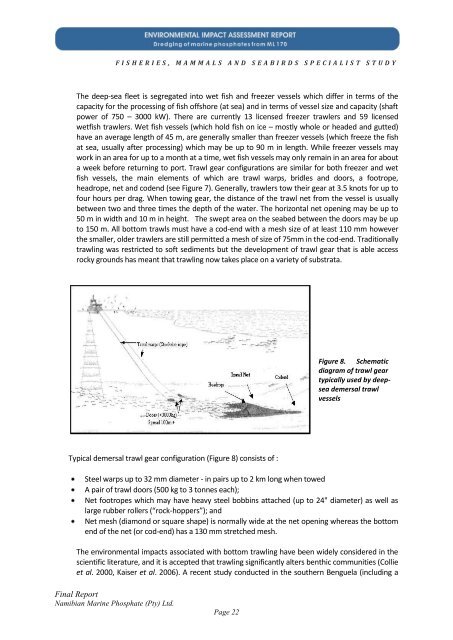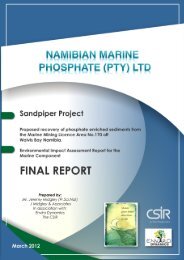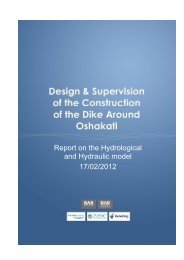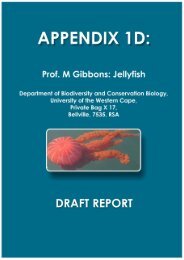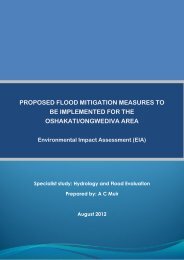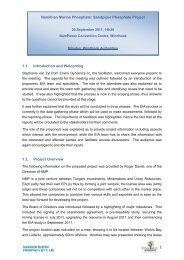Fisheries - Enviro Dynamics Namibia
Fisheries - Enviro Dynamics Namibia
Fisheries - Enviro Dynamics Namibia
Create successful ePaper yourself
Turn your PDF publications into a flip-book with our unique Google optimized e-Paper software.
F I S H E R I E S , M A M M A L S A N D S E A B I R D S S P E C I A L I S T S T U D Y<br />
The deep-sea fleet is segregated into wet fish and freezer vessels which differ in terms of the<br />
capacity for the processing of fish offshore (at sea) and in terms of vessel size and capacity (shaft<br />
power of 750 – 3000 kW). There are currently 13 licensed freezer trawlers and 59 licensed<br />
wetfish trawlers. Wet fish vessels (which hold fish on ice – mostly whole or headed and gutted)<br />
have an average length of 45 m, are generally smaller than freezer vessels (which freeze the fish<br />
at sea, usually after processing) which may be up to 90 m in length. While freezer vessels may<br />
work in an area for up to a month at a time, wet fish vessels may only remain in an area for about<br />
a week before returning to port. Trawl gear configurations are similar for both freezer and wet<br />
fish vessels, the main elements of which are trawl warps, bridles and doors, a footrope,<br />
headrope, net and codend (see Figure 7). Generally, trawlers tow their gear at 3.5 knots for up to<br />
four hours per drag. When towing gear, the distance of the trawl net from the vessel is usually<br />
between two and three times the depth of the water. The horizontal net opening may be up to<br />
50 m in width and 10 m in height. The swept area on the seabed between the doors may be up<br />
to 150 m. All bottom trawls must have a cod-end with a mesh size of at least 110 mm however<br />
the smaller, older trawlers are still permitted a mesh of size of 75mm in the cod-end. Traditionally<br />
trawling was restricted to soft sediments but the development of trawl gear that is able access<br />
rocky grounds has meant that trawling now takes place on a variety of substrata.<br />
Typical demersal trawl gear configuration (Figure 8) consists of :<br />
Final Report<br />
<strong>Namibia</strong>n Marine Phosphate (Pty) Ltd.<br />
Page 22<br />
Figure 8. Schematic<br />
diagram of trawl gear<br />
typically used by deepsea<br />
demersal trawl<br />
vessels<br />
Steel warps up to 32 mm diameter - in pairs up to 2 km long when towed<br />
A pair of trawl doors (500 kg to 3 tonnes each);<br />
Net footropes which may have heavy steel bobbins attached (up to 24" diameter) as well as<br />
large rubber rollers (“rock-hoppers”); and<br />
Net mesh (diamond or square shape) is normally wide at the net opening whereas the bottom<br />
end of the net (or cod-end) has a 130 mm stretched mesh.<br />
The environmental impacts associated with bottom trawling have been widely considered in the<br />
scientific literature, and it is accepted that trawling significantly alters benthic communities (Collie<br />
et al. 2000, Kaiser et al. 2006). A recent study conducted in the southern Benguela (including a


